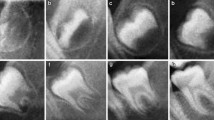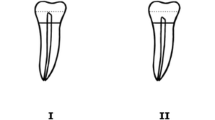Abstract
This paper concerns a method for assessing adult age based on the relationship between age and the third molar maturity index (I3M), which is related to the measurement of the open apices of the third molar. Furthermore, this method was compared to those based on Demirjian’s stages G and H. The sample consisted of 906 Caucasian individuals aged between 14 and 23 years (53.6% females and 46.4% males). Orthopantomographs were analyzed by two observers and calibrated by means of the concordance correlation coefficient for the reproducibility of the third molar maturity index (I3M) and κ statistics for reproducibility of the Demirjian stages. Probabilities for an individual to be older than 18 years of age (adult age) were derived using the measurements of the third molar maturity index (I3M). These results were exploited to set out a threshold value to assign an individual to juvenile or adult age. A cutoff value of I3M = 0.08 was taken. The sensitivity of this test was 70% and specificity was 98%. Furthermore, the proportion of individuals with a correct classification was 83%. The results of the test showed a better specificity when compared to the choice of stage G and a better sensitivity when compared to the choice of stage H for adult age.


Similar content being viewed by others
References
Carothers JC (1947) Age and wisdom teeth in Africans. E Afr Med J 24:304–306
Demirjian A, Goldstein H, Tanner JM (1973) A new system of dental age assessment. Hum Biol 45:211–227
Mincer HH, Harris EF, Berryman HE (1993) The A.B.F.O. study of third molar development and its use as an estimator of chronological age. J Forensic Sci 38:379–390
Solari AC, Abramovitch K (2002) The accuracy and precision of third molar development as an indicator of chronological age in Hispanics. J Forensic Sci 47:531–535
Olze A, Schmeling A, Taniguchi M, Maeda H, van Niekerk P, Wernecke KD, Geserick G (2004) Forensic age estimation in living subjects: the ethnic factor in wisdom tooth mineralization. Int J Legal Med 118:170–173
Olze A, Taniguchi M, Schmeling A, Zhu BL, Yamada Y, Maeda H, Geserick G (2004) Studies on the chronology of third molar mineralization in a Japanese population. Leg Med 6:73–79
Arany S, Iino M, Yoshioka N (2004) Radiographic survey of third molar development in relation to chronological age among Japanese juveniles. J Forensic Sci 49:534–538
Meinl A, Tangl S, Huber C, Maurer B, Watzek G (2007) The chronology of third molar mineralization in the Austrian population—a contribution to forensic age estimation. Forensic Sci Int 169:161–167
Orhan K, Ozer L, Orhan AI, Dogan S, Paksoy CS (2007) Radiographic evaluation of third molar development in relation to chronological age among Turkish children and youth. Forensic Sci Int 165:46–51
Prieto JL, Barbería E, Ortega R, Magaña C (2005) Evaluation of chronological age based on third molar development in the Spanish population. Int J Legal Med 119:349–354
Cameriere R, Ferrante L, Cingolani M (2006) Age estimation in children by measurement of open apices in teeth. Int J Legal Med 120:49–52
Cameriere R, De Angelis D, Ferrante L, Scarpino F, Cingolani M (2007) Age estimation in children by measurement of open apices in teeth: a European formula. Int J Legal Med 121:449–453
Cameriere R, Ferrante L, Cingolani M (2004) The precision and reliability of the pulp/tooth area (RA) of the second molar as indicator of adult age. J Forensic Sci 49:1319–1323
Braga J, Heuze Y, Chabadel O, Sonan NK, Gueramy A (2005) Non-adult dental age assessment: correspondence analysis and linear regression versus Bayesian predictions. Int J Legal Med 119:260–274
Olze A, Bilang D, Schmidt S, Wernecke KD, Geserick G, Schmeling A (2005) Validation of common classification systems for assessing the mineralization of third molars. Int J Legal Med 119:22–26
Blankenship JA, Mincer HH, Anderson KM, Woods MA, Burton EL (2007) Third molar development in the estimation of chronologic age in American blacks as compared with whites. J Forensic Sci 52:428–433
Olze A, Van Niekerk P, Ishikawa T, Zhu BL, Schultz R, Maeda H, Schmeling A (2007) Comparative study on the effect of ethnicity on wisdom tooth eruption. Int J Legal Med 121:445–448
Author information
Authors and Affiliations
Corresponding author
Rights and permissions
About this article
Cite this article
Cameriere, R., Ferrante, L., De Angelis, D. et al. The comparison between measurement of open apices of third molars and Demirjian stages to test chronological age of over 18 year olds in living subjects. Int J Legal Med 122, 493–497 (2008). https://doi.org/10.1007/s00414-008-0279-6
Received:
Accepted:
Published:
Issue Date:
DOI: https://doi.org/10.1007/s00414-008-0279-6




